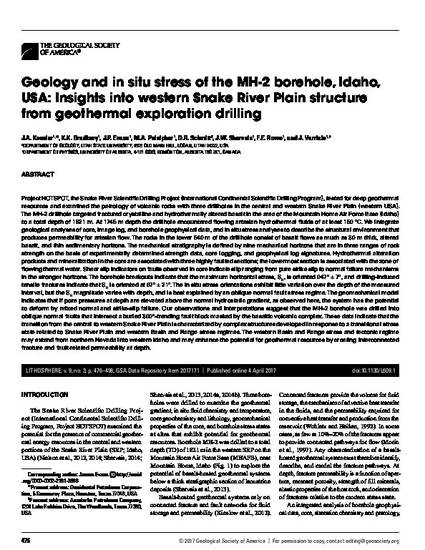
Article
Geology and in situ stress of the MH-2 borehole, Idaho, USA: Insights into western Snake River Plain structure from geothermal exploration drilling
Lithosphere
(2017)
Abstract
Project HOTSPOT, the Snake River Scientific Drilling Project (International Continental Scientific Drilling Program), tested for deep geothermal resources and examined the petrology of volcanic rocks with three drillholes in the central and western Snake River Plain (western USA). The MH-2 drillhole targeted fractured crystalline and hydrothermally altered basalt in the area of the Mountain Home Air Force Base (Idaho)
to a total depth of 1821 m. At 1745 m depth the drillhole encountered flowing artesian hydrothermal fluids of at least 150 °C. We integrate
geological analyses of core, image log, and borehole geophysical data, and in situ stress analyses to describe the structural environment that produces permeability for artesian flow. The rocks in the lower 540 m of the drillhole consist of basalt flows as much as 30 m thick, altered basalt, and thin sedimentary horizons. The mechanical stratigraphy is defined by nine mechanical horizons that are in three ranges of rock strength on the basis of experimentally determined strength data, core logging, and geophysical log signatures. Hydrothermal alteration
products and mineralization in the core are associated with three highly faulted sections; the lowermost section is associated with the zone of flowing thermal water. Shear slip indicators on faults observed in core indicate slip ranging from pure strike slip to normal failure mechanisms in the stronger horizons. The borehole breakouts indicate that the maximum horizontal stress, SH, is oriented 047° ± 7°, and drilling-induced tensile fractures indicate that SH is oriented at 67° ± 21°. The in situ stress orientations exhibit little variation over the depth of the measured
interval, but the SH magnitude varies with depth, and is best explained by an oblique normal fault stress regime. The geomechanical model indicates that if pore pressures at depth are elevated above the normal hydrostatic gradient, as observed here, the system has the potential to deform by mixed normal and strike-slip failure. Our observations and interpretations suggest that the MH-2 borehole was drilled into oblique normal faults that intersect a buried 300°-trending fault block masked by the basaltic volcanic complex. These data indicate that the transition from the central to western Snake River Plain is characterized by complex structures developed in response to a transitional stress state related to Snake River Plain and western Basin and Range stress regimes. The western Basin and Range stress and tectonic regime may extend from northern Nevada into western Idaho and may enhance the potential for geothermal resources by creating interconnected fracture and fault-related permeability at depth.
Keywords
- faults,
- fractures,
- hydrothermal,
- geothermal
Disciplines
Publication Date
2017
DOI
10.1130/L609.1
Citation Information
James Kessler, James P. Evans, Kelly K. Bradbury, Mikayla Pulsipher, et al.. "Geology and in situ stress of the MH-2 borehole, Idaho, USA: Insights into western Snake River Plain structure from geothermal exploration drilling" Lithosphere Vol. 9 Iss. 3 (2017) p. 476 - 498 Available at: http://works.bepress.com/james_evans/120/
Creative Commons license

This work is licensed under a Creative Commons CC_BY International License.
